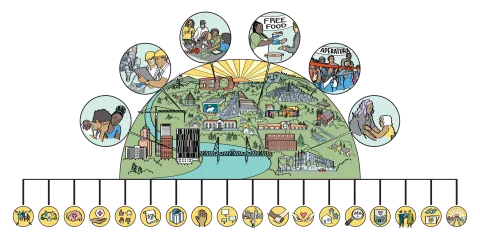
A vision for Transforming Justice in Multnomah County
The centrality of the vision to the work
Through a unique, human-centered process of collaboration between criminal legal system leaders, health system leaders, elected officials, providers, victims of crime, and individuals with lived justice system experience, we developed a long-term vision to drive a strategic planning process for the adult public safety systems. Human-centered processes solve big problems by keeping human experiences (particularly those with legal system contact) in focus. This project focuses on expanding health strategies that provide behavioral health services, medical treatment, housing, and employment, outside of the current traditional criminal legal system.
Transforming Justice's vision promises transformation, rather than tinkering one fiscal year at a time. It should enhance the work already underway. This is a large-scale visioning process for the adult public safety systems.
The Vision
We envision a county where . . .
- the criminal legal system is smaller, focuses on relationships and healing, is trauma-informed, and is used as a last resort
- collateral consequences of criminal convictions are non-existent so people can heal and thrive
- the criminal legal system is equitable and just. Racial and ethnic disparities (and other disparities) are eliminated
- root causes are acknowledged and addressed—but the criminal legal system is not the tool used
- communities create their own localized solutions; place-based solutions work the best
- humans are treated like humans—we recognize and value the human condition—and restorative interventions are the norm
Core Strategies
1: Across everything we do, use human-centered, community-led design
2: Allocate funds to the community to create place-based solutions to public safety
3: Prioritize and fund behavioral health treatment and services that are relevant for the needs of the people
4: Prioritize treatment over punishment when applicable and create partnerships and opportunities to do that effectively
5: “Election-cycle” proof the work – build resilience to counter messaging
6: Change and/or eliminate law, budget, and policy that disproportionately harms people of color
7: Use positive reinforcement more than punitive measures
8: Deploy interventions that reduce harm and use the criminal legal system in a more limited way
9: Incorporate a variety of victim voices in all system reform efforts
10: Develop non-traditional partnerships to enhance prosocial opportunities
11: Prioritize community-building between law enforcement officers and the neighborhoods they patrol
12: Focus on wellness as a key strategy for everyone
13: Enhance safety-net services to address basic needs and root causes of crime
14: Establish systems of accountability for criminal legal system change
15: Increase public safety by ensuring the right use of accountability
16: Identify ways to increase supports, resources, and legal system alternatives to families and children
17: Reform policies and laws surrounding criminal records
18: Ensure criminal background is not a barrier to housing access, employment opportunities, and education
Why a vision? What's it for?
A vision provides value-based, directional guidance for broad and various stakeholders to apply to legislative, policy, or budget changes to transform expensive, poor outcomes.
